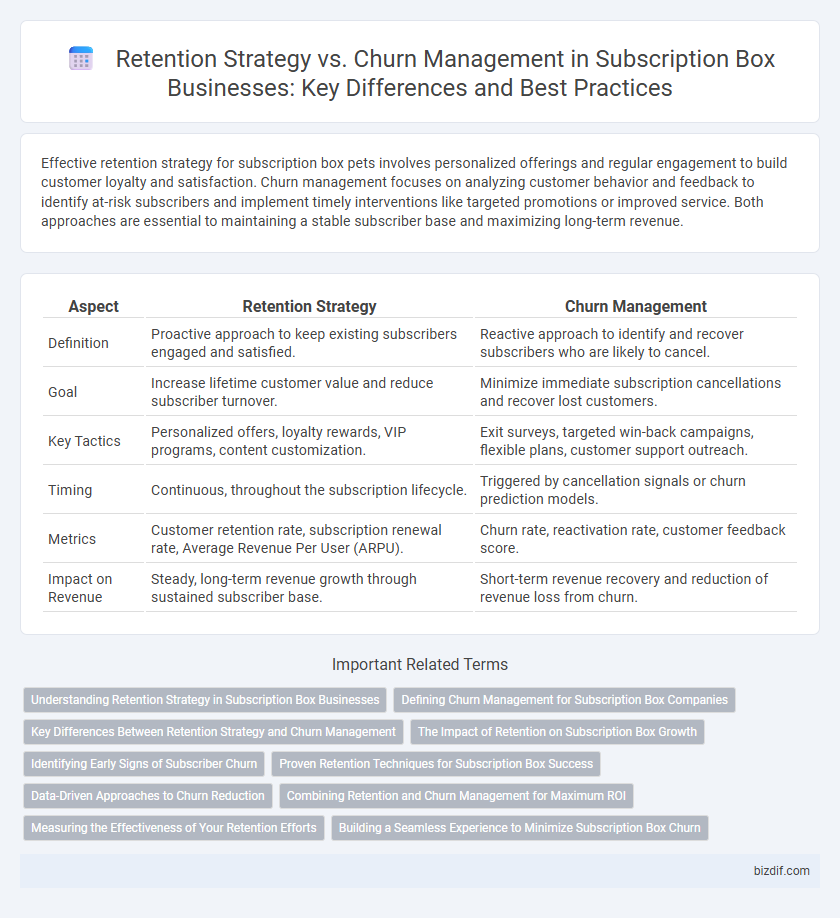Effective retention strategy for subscription box pets involves personalized offerings and regular engagement to build customer loyalty and satisfaction. Churn management focuses on analyzing customer behavior and feedback to identify at-risk subscribers and implement timely interventions like targeted promotions or improved service. Both approaches are essential to maintaining a stable subscriber base and maximizing long-term revenue.
Table of Comparison
| Aspect | Retention Strategy | Churn Management |
|---|---|---|
| Definition | Proactive approach to keep existing subscribers engaged and satisfied. | Reactive approach to identify and recover subscribers who are likely to cancel. |
| Goal | Increase lifetime customer value and reduce subscriber turnover. | Minimize immediate subscription cancellations and recover lost customers. |
| Key Tactics | Personalized offers, loyalty rewards, VIP programs, content customization. | Exit surveys, targeted win-back campaigns, flexible plans, customer support outreach. |
| Timing | Continuous, throughout the subscription lifecycle. | Triggered by cancellation signals or churn prediction models. |
| Metrics | Customer retention rate, subscription renewal rate, Average Revenue Per User (ARPU). | Churn rate, reactivation rate, customer feedback score. |
| Impact on Revenue | Steady, long-term revenue growth through sustained subscriber base. | Short-term revenue recovery and reduction of revenue loss from churn. |
Understanding Retention Strategy in Subscription Box Businesses
Retention strategy in subscription box businesses centers on enhancing customer lifetime value by delivering personalized experiences, timely engagement, and exclusive offers that encourage ongoing subscriptions. Data analytics plays a crucial role in identifying customer preferences and behaviors, enabling businesses to tailor content and product selections that resonate with subscribers. Proactive retention tactics such as loyalty rewards, frictionless renewal processes, and responsive customer support significantly reduce churn rates and stabilize revenue streams.
Defining Churn Management for Subscription Box Companies
Churn management for subscription box companies involves identifying and addressing the reasons customers cancel their subscriptions to minimize revenue loss and maintain steady growth. Effective churn management leverages data analytics to detect early warning signs of dissatisfaction, enabling timely interventions such as personalized offers or improved customer service. This strategic focus differs from retention by concentrating specifically on reducing cancellations rather than solely enhancing customer loyalty.
Key Differences Between Retention Strategy and Churn Management
Retention strategy emphasizes proactive techniques to enhance customer loyalty and increase lifetime value through personalized offers and engagement, whereas churn management focuses on identifying at-risk customers and implementing reactive measures to prevent cancellations. Key differences lie in timing and approach: retention strategies are ongoing and relationship-building, while churn management targets specific customer segments showing signs of defection. Optimizing subscription box success requires integrating both by continuously nurturing subscribers and swiftly addressing churn indicators to maintain steady revenue growth.
The Impact of Retention on Subscription Box Growth
Retention strategy directly influences subscription box growth by increasing customer lifetime value and reducing acquisition costs. Effective retention efforts such as personalized offers, loyalty rewards, and engaging content lead to higher subscriber satisfaction and lower churn rates. Companies that prioritize retention see sustainable revenue growth and a stronger competitive position in the subscription box market.
Identifying Early Signs of Subscriber Churn
Monitoring subscriber engagement metrics such as login frequency, unboxing interaction, and feedback response rates reveals early signs of subscriber churn in subscription box services. Analyzing these behavioral patterns enables proactive retention strategies like personalized offers and tailored content to re-engage at-risk customers. Effective churn management hinges on leveraging data-driven insights to anticipate cancellations before they occur, minimizing revenue loss and sustaining long-term subscriber loyalty.
Proven Retention Techniques for Subscription Box Success
Proven retention techniques for subscription box success include personalized product recommendations, exclusive member benefits, and consistent engagement through curated content. Leveraging data analytics to anticipate subscriber preferences enhances loyalty and reduces churn rates. Implementing a seamless cancellation flow paired with proactive outreach addresses potential cancellations before they occur.
Data-Driven Approaches to Churn Reduction
Data-driven approaches to churn reduction in subscription boxes leverage customer behavior analytics and predictive modeling to identify at-risk subscribers before cancellation. By utilizing machine learning algorithms on purchase history, engagement metrics, and feedback data, companies create personalized retention strategies that enhance customer satisfaction and extend lifecycle value. Continuous monitoring and A/B testing of retention tactics ensure optimized interventions that lower churn rates and maximize recurring revenue.
Combining Retention and Churn Management for Maximum ROI
Combining retention strategy and churn management enhances subscription box business performance by reducing customer churn and increasing lifetime value. Leveraging personalized offers, proactive engagement, and data-driven insights optimizes customer satisfaction and loyalty. Prioritizing this integrated approach maximizes ROI through sustained subscriber growth and cost-effective customer acquisition.
Measuring the Effectiveness of Your Retention Efforts
Measuring the effectiveness of your retention efforts in subscription box services involves analyzing key metrics such as customer lifetime value (CLV), churn rate, and repeat purchase frequency. Tracking engagement through personalized communication and satisfaction surveys helps identify successful retention strategies and areas needing improvement. Consistent data monitoring enables businesses to optimize retention tactics, reduce churn, and increase long-term subscriber loyalty.
Building a Seamless Experience to Minimize Subscription Box Churn
Building a seamless subscription box experience directly impacts customer retention by reducing friction in order management, personalized product selection, and timely delivery. Leveraging data-driven insights to anticipate customer preferences enhances satisfaction and loyalty, minimizing the risk of churn. Implementing intuitive user interfaces and proactive communication fosters trust, ensuring subscribers remain engaged and less likely to cancel.
Retention strategy vs Churn management Infographic

 bizdif.com
bizdif.com